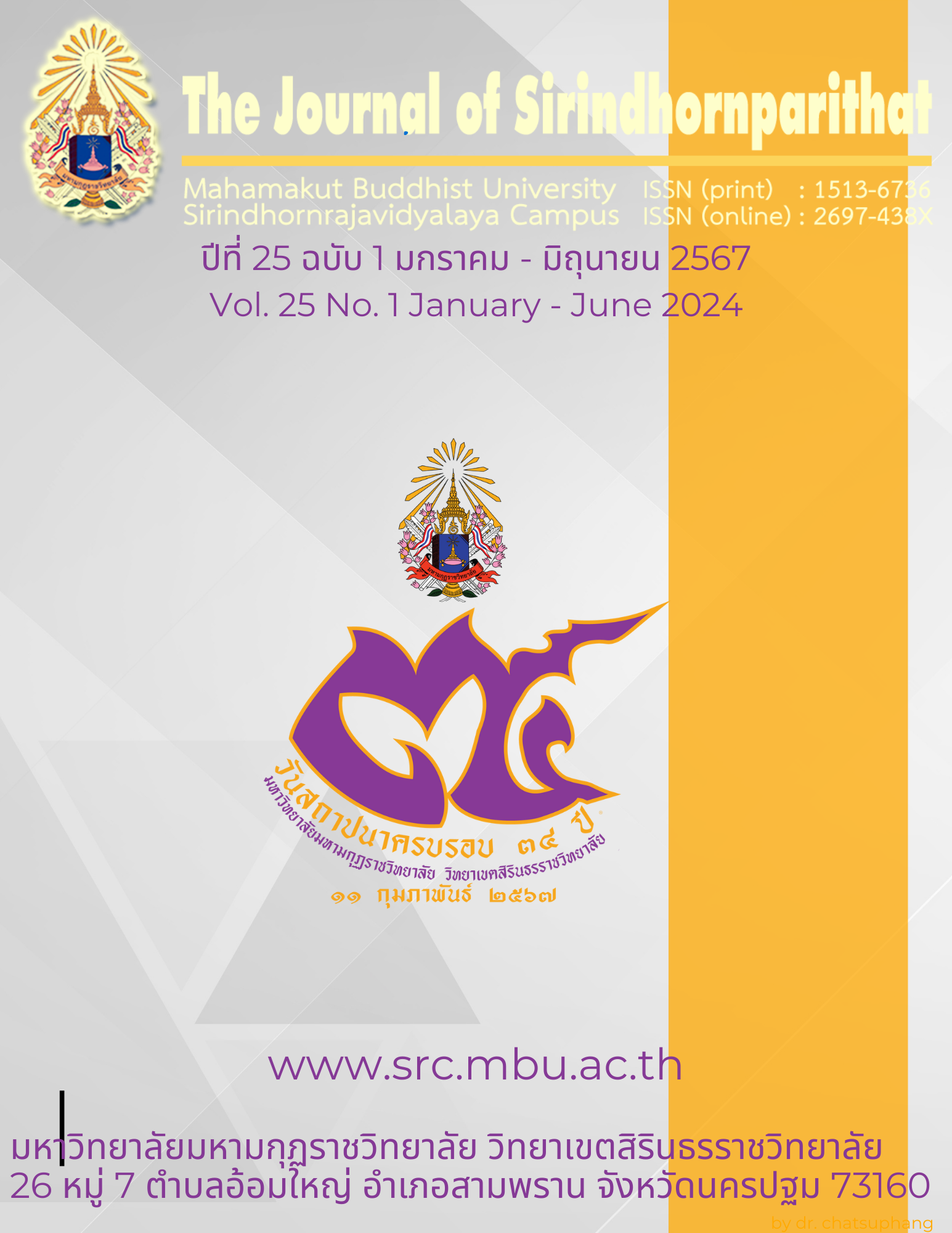Outcomes Learning by Multimedia Motion Graphics with Cooperative Learning Technique Competition Between Groups with Games Towards the Ability of Solutions for Secondary Level 1 Students
Keywords:
Motion graphics multimedia, Cooperative learning techniques of intergroup competition with games, Problem solving abilityAbstract
The purposes of this research were 1) To study students' problem-solving abilities after learning with multimedia motion graphics and cooperative learning management techniques for intergroup competition with games. 2) To study the results of group work of students learning using multimedia motion graphics in combination with cooperative learning management techniques of intergroup competition with games. 3) To study the satisfaction of Grade 1 students who learned using motion graphics combined with cooperative learning techniques of intergroup competition with games. The sample is students of mathayomsuksa 1/3 at Dipangkornwittayapat (Taweewattana) Under Royal Patronage School. Academic year 2021, 40 students. The research instruments were 1) A multimedia learning plan with motion graphics combined with collaborative learning. Techniques for competing between groups with games 2)multimedia motion graphics Fundamentals of Science, Technology (Computational Science), Mathayomsuksa 1 Chapter 2 on Problem Solving 3) Questionnaire students' ability to solve problems with algorithms 4) group work assessment form Fundamental Science Technology (Computational Science) Level 1 5) Student satisfaction questionnaire affecting learning with motion graphics combined with cooperative learning techniques of intergroup competition with games. The results of the research were as follow 1) The students' problem-solving abilities after learning with multimedia motion graphics combined with cooperative learning and game-based competition techniques were good. 2) The results of the collaboration of students with multimedia, motion graphics combined with cooperative learning, the technique of intergroup competition with most games were at a very good level. 3) Student satisfaction with multimedia learning with motion graphics combined with collaborative learning The technique of competition between groups with games was at the most satisfactory level. ( = 4.54, S.D. = .017)
References
กระทรวงศึกษาธิการ. (2561). หลักสูตรแกนกลางการศึกษาขั้นพื้นฐาน พุทธศักราช 2551 (ฉบับปรับปรุง พ.ศ. 2560). สำนักงานวิชาการและมาตรฐานการศึกษา สำนักงานคณะกรรมการการศึกษาขั้นพื้นฐาน. [ออนไลน์]. สืบค้นจาก http://academic.obec.go.th/ newsdetail.php?id=75.
กระทรวงศึกษาธิการ. (2563). นโยบายและจุดเน้นของกระทรวงศึกษาธิการ. กรุงเทพมหานคร : สำนักงานวิชาการและมาตรฐานการศึกษาสำนักงานคณะกรรมการการศึกษาขั้นพื้นฐานกระทรวงศึกษาธิการ.
คณะกรรมการอิสระเพื่อการปฏิรูปด้านการศึกษา. (2564). แผนการปฏิรูปประเทศด้านการศึกษา. สำนักงานสภาพัฒนาการเศรษฐกิจและสังคมแห่งชาติ. [ออนไลน์]. สืบค้นจาก https://lamphuncity.go.th/wp-content/uploads/2020/05.
จงรัก เทศนา. (2560). อินโฟกราฟิกส์. [ออนไลน์]. สืบค้นจาก http://www.krujongrak. com/infographics/ infographics_information.pdf.
ชาญวิทย์ เทียมบุญประเสริฐ. (2528). การวัดความถนัด. กรุงเทพนมหานคร : มหาวิทยาลัยศรีนครินทรวิโรฒ ประสารมิตร.
ทิศนา แขมมณี. (2555). ศาสตร์การสอน: องค์ความรู้เพื่อการจัดกระบวนการเรียนรู้ที่มีประสิทธิภาพ. พิมพ์ครั้งที่ 15. กรุงเทพมหานคร: จุฬาลงกรณ์มหาวิทยาลัย.
วัฒนาพร ระงับทุกข์. (2542). การจัดการเรียนการสอนที่เน้นผู้เรียนเป็นศูนย์กลาง. กรุงเทพมหานคร: เลิฟ แอนด์ เลิฟ เพรส.
สารสิน เล็กเจริญ. (2554). การเปรียบเทียบผลสัมฤทธิ์ทางการเรียนเรื่องการเขียนสะกดคำของนักเรียน ชั้นประถมศึกษาปีที่ 1 ที่ได้รับการสอนโดยการเรียนแบบร่วมมือเทคนิค TGT กับการสอนแบบปกติ. วิทยานิพนธ์ปริญญาครุศาสตรมหาบัณฑิต. สาขาวิชาการสอนภาษาไทย ภาควิชาหลักสูตรและวิธีสอน มหาวิทยาลัยศิลปากร.
Baroody, A.J. (1993). Children’s Mathematical thinking. New York: Teacher College.
Johnson & Johnson. (1994). Learning Together and Alone. Cooperative, Competitive, and Individualistic Learning (Fourth Edition): Edina, Minn.: Interaction Book Company.
Slavin Robert E. (1987). Cooperatives learning and cooperatives schools. Education Leadership.

Downloads
Published
Issue
Section
License
Copyright (c) 2024 Mahamakut Buddhist University

This work is licensed under a Creative Commons Attribution-NonCommercial-NoDerivatives 4.0 International License.
บทความที่ได้รับการตีพิมพ์เป็นลิขสิทธิ์ของ มหาวิทยาลัยมหามกุฏราชวิทยาลัย วิทยาเขตสิรินธรราชวิทยาลัย
ข้อความที่ปรากฏในบทความแต่ละเรื่องในวารสารวิชาการเล่มนี้เป็นความคิดเห็นส่วนตัวของผู้เขียนแต่ละท่านไม่เกี่ยวข้องกับหาวิทยาลัยมหามกุฏราชวิทยาลัย วิทยาเขตสิรินธรราชวิทยาลัย และคณาจารย์ท่านอื่นๆในมหาวิทยาลัยฯ แต่อย่างใด ความรับผิดชอบองค์ประกอบทั้งหมดของบทความแต่ละเรื่องเป็นของผู้เขียนแต่ละท่าน หากมีความผิดพลาดใดๆ ผู้เขียนแต่ละท่านจะรับผิดชอบบทความของตนเองแต่ผู้เดียว



